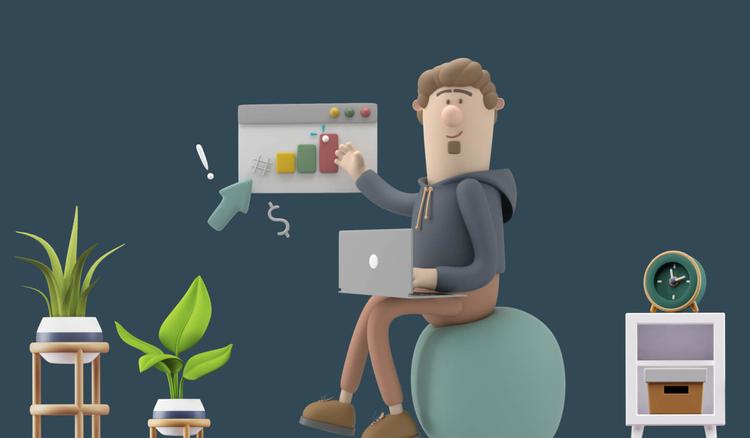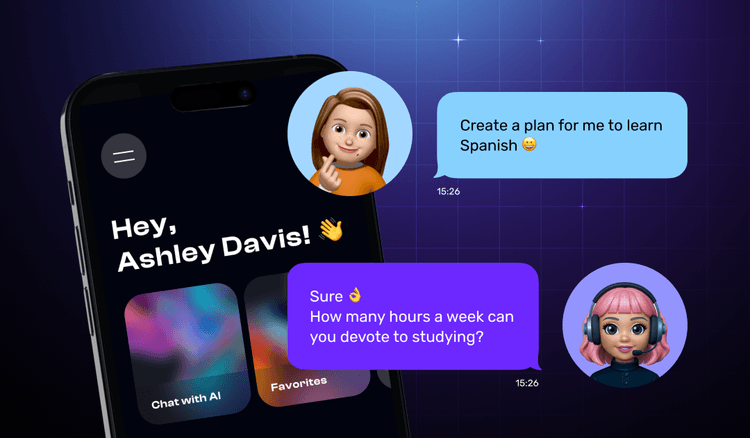In a world where time is priceless, daily convenience reigns supreme. And nothing embodies this convenience more than an online marketplace.
Sure, the e-commerce arena is quite competitive, and many startups hesitate to jump in. But let's put those fears aside, as statistics paint a promising picture.
In 2023, online retail soared to a jaw-dropping $5.8 trillion. Now, hold your hats because experts predict a whopping 39% surge in the years ahead – e-commerce is about to hit the $8 trillion mark by 2027.
There's never been a better time to ride the wave of e-commerce growth, so there’s room for any e-commerce business idea. In this guide, we'll walk you through the essentials of marketplace app development, covering core features, basic steps, and costs. So buckle up, and let's get started!
Marketplace app: is it worth building?
While it's no secret that online marketplaces are a profitable endeavor, these factors may fuel your entrepreneurial fire to start building a marketplace of your own:
Global reach | With an online marketplace, your potential customer base isn't limited to a single geographic location. The Internet breaks down boundaries and allows users to shop worldwide all from the comfort of their couches (pajamas optional)! Such broad reach means you can tap into markets you might have never considered before and gain significant profit.
Scalability | One of the most attractive aspects of marketplace app development is scalability. As your business grows, you can quickly scale up your marketplace to accommodate more customers, sellers, and products. With the right technology and expert development team, scaling your online marketplace app can be relatively smooth and cost-effective.
Flexibility and innovation | You have the freedom to experiment with different business models, product offerings, and marketing strategies to find what works best for your target audience. Plus, tech innovations, such as AI-driven personalization, mobile shopping experiences, and blockchain-based transactions, continually push the boundaries of what's possible in the online marketplace space. By staying agile, you can gain a competitive advantage and deliver exceptional customer value. If you’re a reseller looking to expand your reach, using the best crosslisting apps for resellers can help you quickly list products across multiple marketplaces, saving time and boosting visibility.
"One more advantage to add to the profitability of marketplace projects is the array of monetization opportunities they offer. Some of these methods include:
-
Partnership contracts with vendors
-
Commission-based models for transactions
-
Advertising opportunities
-
Paid promotional features
-
Fees for additional services
By strategically leveraging these avenues, businesses can maximize their revenue potential and create sustainable source of income."
Natalia Ivleva, Lead BA at SolveIt
Marketplace app development: most inspiring examples
Before we dive into the essentials of marketplace app development, let’s get inspired by successful examples of popular online retailers:
Amazon
Arguably the undisputed king of online marketplaces, Amazon needs no introduction. Founded by Jeff Bezos in 1994 as an online bookstore, it has since evolved into a one-stop shop for nearly every category imaginable. From household essentials to electronics and even groceries, Amazon's ecosystem connects millions of sellers with a global audience. Its Prime membership program, offering perks like free two-day shipping and streaming content, has further solidified Amazon’s dominance in the e-commerce space.
eBay
Thriving on its auction format, eBay has been connecting buyers and sellers since 1995. eBay started as a platform to buy and sell used goods and eventually has grown into a global marketplace with items across various categories. It's a treasure hunter's paradise, perfect for seeking unique vintage finds or grabbing incredible deals on everyday items. eBay's auction-style listings and "Buy It Now" feature provide flexibility for both buyers and sellers.
Fiverr
Fiverr is an online services marketplace catering to freelancers and small businesses. The platform has democratized access to professional digital services, making it easy to find affordable and high-quality solutions. Whether you need a website revamp or a catchy jingle for your business, Fiverr connects you with talented individuals ready to bring your vision to life.
Zillow
Zillow is the go-to destination for all real estate things. Whether you're looking to buy, sell, or rent, Zillow has you covered with its extensive database of properties, expert insights, and intuitive search tools. With millions of listings and a user-friendly interface, finding your dream home or investment property has never been easier.
Real estate app development in 2025
Read articleMarketplace development: app types
There are three main types of marketplace apps categorized by the interaction between buyers and sellers:
Business-to-Consumer (B2C) | This is the most familiar marketplace model, connecting businesses (sellers) directly with individual consumers (buyers). These platforms offer a vast selection of products across various categories, allowing buyers to compare prices and find the best deals.
Business-to-Business (B2B) | Here, the marketplace connects businesses with other businesses. These platforms often cater to specific industries or niches, such as wholesale marketplaces for retailers or platforms connecting companies with service providers.
Peer-to-Peer (C2C) | This model allows individuals to sell directly to other individuals. Users can interact with each other without the involvement of businesses, offering unique finds and fostering a sense of community.
In addition to these core types, there are also hybrid models that combine aspects of several categories. For instance, a marketplace can connect businesses with consumers (B2C) while also offering a C2C section for reselling used goods.
Building a marketplace: most essential features
To create an online marketplace that can win users’ hearts, you need to cater to both sides of the coin: buyers and sellers. Let's delve into the features you simply can’t overlook:
For Buyers
- User account management. A user account is a central hub for managing the shopping experience. It includes features like account creation, secure login, and the ability to edit profile information, shipping addresses, and payment methods. A user-friendly account management system keeps things organized and empowers buyers to shop confidently.
- Product search and filters. Robust search and filtering options give buyers the power to find exactly what they're looking for. Comprehensive filtering by category, brand, price, color, size, or other parameters helps users narrow their choices and discover products and services that meet their needs.
- Secure payment. Ensuring security is crucial in the realm of online shopping. Whether it's credit/debit card payments, digital wallets, or alternative payment methods, prioritize security and reliability to reassure customers that their transactions are protected.
- Product reviews and ratings. User feedback is essential in establishing trust. When building a marketplace, enable buyers to share their experiences and opinions on products they've purchased. This helps future buyers make informed decisions and fosters a sense of community within your marketplace.
- Order tracking. No one likes waiting in the dark. Provide a transparent order tracking system that allows buyers to monitor the status of their purchases in real time. From purchase confirmation to shipping updates and delivery notifications, keep buyers in the loop at every step.
- Wishlist (or favorites). This feature provides a convenient way to bookmark items of interest and get quick access to them when needed. In fact, wishlists can be a powerful retention tool. They fuel excitement and keep users coming back to the app to revisit their list, check prices, or wait for the perfect buying opportunity.
- Messaging tools. Direct communication is always a plus. Implement communication tools that allow buyers to interact with sellers, ask questions about products, and negotiate terms. By facilitating open and transparent communication, you foster confidence in the buying process.
For Sellers
- Seller profiles. Streamline the onboarding process for sellers to make it as painless as possible. From professional brand accounts to product categories, provide clear guidance to encourage more sellers to join your marketplace.
- Product listing and management. Listing products should be a breeze. Empower sellers to create and manage their product listings with a user-friendly dashboard. Provide intuitive tools for uploading product images, writing compelling descriptions, and setting pricing. Plus, consider features like bulk editing and variations.
- Order management system. Tracking incoming orders and inventory is crucial for any seller's success. Provide an order management system and centralized dashboard that allow sellers to track orders, manage inventory, and process transactions. Real-time data and clear visualizations can help sellers stay organized and efficient.
- Seller analytics. Equip sellers with insightful analytics to help them understand their performance and choose data-driven strategies. Tools like Shopify or Amazon product analytics should track key metrics like sales performance, product popularity, and customer demographics. While blogging on Shopify boosts your store's visibility and engagement, integrating robust analytics ensures that you’re making informed decisions to optimize your business strategy.
- Customer support. Even the smoothest marketplace has occasional bumps. Provide sellers with access to dedicated customer support options. This could include a ticketing system, a top live chat software, or even a knowledge base with helpful resources. Addressing customer concerns promptly builds positive relationships, the status of which you can track using customer experience analytics software. In addition, customer retention software can help monitor engagement levels and ensure ongoing satisfaction.
- Seller feedback. Feedback is a two-way street. Consider a system for sellers to respond to buyer reviews, demonstrating their commitment to improving customer satisfaction.
- Seller verification. Implement a system to recognize and verify trusted sellers through badges or verification symbols. This helps build credibility and trust among buyers, increasing their confidence in purchasing from verified sellers.
When it comes to selecting the perfect features for your online marketplace, a little expert guidance can make a difference. Find a trusted service provider with relevant expertise to help you make the right choices for your unique case.
How to choose a mobile app development company?
Read articleHow to build an online marketplace: 8 steps
Conduct market research
Start with a thorough discovery phase to understand your audience, discover your niche, and determine the unique selling point (USP) that makes your marketplace special. By examining demographics, behaviors, and pain points, you'll shape your strategy for further marketplace app development.
Whether you're targeting busy professionals or passionate hobbyists, market research helps you identify opportunities and stand out from the competition.
Decide on the core features
Now that you know your market, it's time to define the core functionalities. Ensure that both buyers and sellers have everything they need to engage effectively on your platform.
For buyers, it's about creating a seamless shopping experience with easy navigation, secure payment options, and detailed product listings. Sellers need tools to manage their inventory efficiently, communicate with buyers, and track sales.
Choose monetization model
Consider how you'll generate revenue from your marketplace. Common monetization strategies include transaction fees, subscription plans, advertising, and premium features. For example, if you create an online marketplace for B2B, you might charge businesses a monthly subscription fee to access premium features and services.
Develop an MVP
Building an MVP (Minimum Viable Product) of your marketplace allows you to see what resonates with users and what needs tweaking before you create a full-scale app. This is crucial because your initial concept might not be exactly what your target audience craves.
If you’re new to the app development process, we recommend you consider partnering with a skilled provider who can guide you from validating your idea to launching your marketplace. A professional team has the expertise to turn your vision into reality, saving you time and ensuring a smooth journey. When it comes to MVP development services for startups, working with an experienced provider can be immensely helpful in bringing your marketplace concept to life in a cost-effective and efficient manner.
Let’s tURN your marketplace idea into working MVP!
Contact usFocus on intuitive UI/UX design
Many product owners believe that design can take a back seat during the MVP stage, but that's a misconception. In reality, UI/UX design plays a crucial role in shaping the user impression and validating your marketplace idea.
So, don’t skimp time and resources on the intuitive and appealing design from the start, as it sets the foundation for a successful marketplace.
How much does it cost to design an app?
Read articleTest the MVP to collect feedback
Launch your marketplace MVP to a small group of users and gather feedback on their experience. Pay attention to usability issues, feature requests, and any pain points users encounter. Various usability testing tools can help you do that.
Turn MVP into a full-scale app
Once you've collected feedback and validated your concept, iterate on your MVP to incorporate additional features and improvements. The process might involve adding new functionality, refining existing features, and optimizing performance.
How long does it take to develop an app?
Read articleTest again & launch
Before launching your full-scale app to the public, thoroughly test it again to ensure all features work correctly and the user experience is seamless. Conduct usability, performance, and security testing to identify and address any issues.
PS: Once your marketplace is up and running, the journey doesn't stop there. You have to stick around to provide ongoing support and monitor user feedback. And, as your platform grows, you might need to scale it up to keep pace with demand.
Marketplace app development cost
Now, let’s talk shop: how much do you need to create a marketplace? If we’re considering MVP development, the price tag starts at around $30,000. At this cost, you get the basic version of your app, enough to test your idea.
Now, if you're thinking about going all-in, the cost to develop a full-scale app usually starts from around $90,000. This includes extra features and a more polished user experience.
Remember, these are just averages, and the final marketplace app development cost can vary depending on factors like the app type and complexity, your niche, and developers’ rates.
Marketplace app development [SolveIt experience]
B2B Marketplace for Small Appliances
Jabal is a global online B2B platform that connects verified sellers and buyers of small appliances, founded by entrepreneurs from Dubai. The Jabal team approached SolveIt to develop a web marketplace app to digitize and automate their existing successful offline business.
Through a comprehensive discovery phase, we identified the app's logic and selected an appropriate tech stack, resulting in a fully functioning MVP web app built on React. We implemented a subscription monetization model and created a landing page to drive traffic, laying a strong foundation for business revenue generation.
Our holistic approach included not only development but also ongoing support, ensuring scalability and a user-friendly experience. The Jabal platform now efficiently manages order statuses, financial operations, and customer feedback, creating a seamless experience for both buyers and vendors.
On-demand marketplace for service providers
Ymaster is an on-demand marketplace for service providers. By utilizing a special algorithm, the platform allows to order tow trucks, mobile buses, or any other technical assistance that fits relevantly in terms of request criteria and geographic location.
We have proposed to the client a subscription monetization model, which entails a fixed cost for utilizing the service for 3 months, 6 months, and 1 year, plus a free trial period for contributors.
SolveIt has successfully completed the entire development cycle, from discovery to launch, providing ongoing support. Our team has developed Android and iOS mobile apps, an admin panel, and landing pages to create a seamless platform for connecting service providers with customers. Moreover, we offered our promotion expertise: from branding, creating a logo, and app naming to the creation of marketing strategy, social media presence, and targeted advertising.
Thanks to this holistic approach, the app gained 3000+ downloads and a 23.8% retention rate in the first few months.
Cargo ordering marketplace platform
CouCouVan operates similarly to Uber, providing comprehensive iOS and Android apps for users to find the nearest driver with a van and order services without phone calls.
We provided a turnkey solution in 6 months by delivering mobile and web apps for users, a dedicated driver app, as well as an admin panel and dispatcher dashboard for efficient management. The discovery phase helped to minimize development risks and stay within budget and timeframes.
From idea to app publishing, we built a software ecosystem that works smoothly for every type of users: customers, drivers, admins, and business owners. The system has an intuitive design and seamlessly supports all 3rd party integrations for full functionality.
Rental marketplace
Hemie is a rental marketplace that simplifies the process of finding, exchanging, and renting homes. The SolveIt team was entrusted with go-live cross-platform apps for both iOS and Android that perform with improved front- and back-end functions.
As we provided project rescue services from a previous technology provider, the app had a significant number of bugs and an inability to handle peak loads. That is why the development process was divided into stages: reviewing the current state of the app, rethinking the architecture, and initiating a redesign.
Only after that did we implement subscription management, location-based enhancements, and the most innovative feature—a third-party exchange—that allows people to rent properties between 3 people and move to each other's houses easily without utilizing agents' services. Following the successful release of mobile apps, there are plans for further collaboration in the development of a web platform.
Final word
Now, you're all set to navigate the exciting world of marketplace app development. Luckily, the e-commerce boom is here, so it's time to put your groundbreaking ideas into action.
Whether you’re dreaming up a big thing or planning to fine-tune your existing marketplace, we're here to help at every step of the way. Contact SolveIt today, and let's build your own marketplace together!

![How to launch an app in 2025 [16 proven steps for success]](/_next/image?url=https%3A%2F%2Fsolveit.dev%2Frails%2Factive_storage%2Fblobs%2FeyJfcmFpbHMiOnsibWVzc2FnZSI6IkJBaHBBa0VFIiwiZXhwIjpudWxsLCJwdXIiOiJibG9iX2lkIn19--ab46d02ce3dd95274448f03f7e1818c6809ec8b9%2Fcover2.jpg&w=750&q=75)

